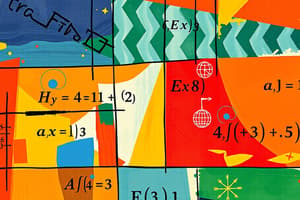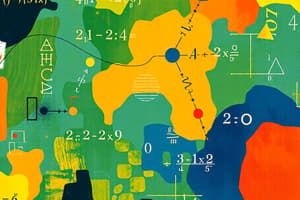Podcast
Questions and Answers
What distinguishes a polynomial from a monomial and a binomial?
What distinguishes a polynomial from a monomial and a binomial?
A polynomial consists of multiple terms, while a monomial has a single term and a binomial has exactly two terms.
How do you solve a linear equation like 2x + 3 = 7?
How do you solve a linear equation like 2x + 3 = 7?
To solve it, first subtract 3 from both sides to get 2x = 4, then divide both sides by 2 to find x = 2.
What is the significance of the quadratic formula in solving quadratic equations?
What is the significance of the quadratic formula in solving quadratic equations?
The quadratic formula provides a systematic way to find the solutions of any quadratic equation in the form ax² + bx + c = 0.
Explain the difference between solving systems of equations by substitution and elimination.
Explain the difference between solving systems of equations by substitution and elimination.
What are the characteristics of a linear function and how is it represented?
What are the characteristics of a linear function and how is it represented?
Describe the purpose of factoring in algebra.
Describe the purpose of factoring in algebra.
What is an inequality and how does its notation differ from an equation?
What is an inequality and how does its notation differ from an equation?
How do you graph an equation in slope-intercept form?
How do you graph an equation in slope-intercept form?
Flashcards are hidden until you start studying
Study Notes
Algebra Study Notes
1. Fundamental Concepts
- Variables: Symbols representing numbers (e.g., x, y).
- Constants: Fixed values (e.g., 5, -3).
- Expressions: Combinations of variables, constants, and operators (e.g., 2x + 3).
- Equations: Mathematical statements asserting equality (e.g., 2x + 3 = 7).
2. Operations
- Addition and Subtraction: Basic operations with like and unlike terms.
- Multiplication: Use distributive property for expansion (e.g., a(b + c) = ab + ac).
- Division: Involves dividing terms and simplifying fractions.
3. Solving Equations
-
Linear Equations: Form ax + b = 0.
- Goal: Isolate x.
- Example: 2x + 3 = 7 → 2x = 4 → x = 2.
-
Quadratic Equations: Form ax^2 + bx + c = 0.
- Solutions via factoring, completing the square, or quadratic formula: x = [-b ± √(b²-4ac)] / 2a.
4. Functions
- Definition: A relation where each input (x) maps to exactly one output (y).
- Notation: f(x) represents a function.
- Types of functions:
- Linear Functions: Graph as a straight line (y = mx + b).
- Quadratic Functions: Form a parabola (y = ax^2 + bx + c).
5. Graphing
- Coordinate System: Cartesian plane with x (horizontal) and y (vertical) axes.
- Plotting Points: Denoted as (x, y).
- Slope-Intercept Form: y = mx + b, where m is the slope and b is the y-intercept.
6. Systems of Equations
- Definition: A set of equations with the same variables.
- Methods of Solving:
- Graphing: Finding points of intersection.
- Substitution: Solving one equation for a variable and substituting.
- Elimination: Adding or subtracting equations to eliminate a variable.
7. Polynomials
- Definition: Expressions involving variables raised to whole-number powers.
- Classification:
- Monomial: A single term (e.g., 3x).
- Binomial: Two terms (e.g., x + 2).
- Polynomial: Multiple terms (e.g., 2x^2 + 3x + 1).
- Operations: Addition, subtraction, multiplication, and division (synthetic division).
8. Factoring
- Purpose: Breaking down expressions into simpler components.
- Common Methods:
- GCF (Greatest Common Factor): Factor out the largest term.
- Factoring by grouping: Group terms to find common factors.
- Quadratic trinomial: Factor forms like ax^2 + bx + c.
9. Inequalities
- Definition: Expressions identifying the relationship between values (e.g., x > 5).
- Graphing: Use a number line; open circles for < or >, closed for ≤ or ≥.
- Solving: Similar to equations, but reverse inequality sign when multiplying/dividing by a negative.
10. Exponents and Radicals
-
Exponent Rules:
- Product of powers: a^m * a^n = a^(m+n).
- Power of a power: (a^m)^n = a^(mn).
- Zero exponent: a^0 = 1 (a ≠ 0).
-
Radicals:
- Square roots (√), cube roots (∛), and properties of radical expressions.
These notes cover fundamental elements and techniques in algebra that are essential for problem-solving and application in higher mathematics.
Fundamental Concepts
- Variables are symbols that represent unknown numbers. Examples include x, y, and z.
- Constants are fixed numerical values that do not change. Examples include 5, -3, and 1/2.
- Expressions are combinations of variables, constants, and mathematical operations. An example is 2*x + 3.
- Equations are mathematical statements that assert the equality of two expressions. An example is 2*x + 3 = 7.
Operations
- Addition and subtraction are basic arithmetic operations used to combine or separate terms.
- Multiplication involves combining terms. The distributive property is used to expand expressions like a(b + c) = ab + ac.
- Division involves dividing terms and simplifying fractions.
Solving Equations
- Linear equations have the form ax + b = 0, where a and b are constants. The goal is to isolate x.
- Quadratic equations have the form ax² + bx + c = 0, where a, b, and c are constants. Solutions can be found using factoring, completing the square, or the quadratic formula: x = [-b ± √(b² - 4ac)] / 2a.
Functions
- A function is a mathematical relationship where each input value (x) maps to a unique output value (y).
- Function notation uses the form f(x) to represent the output of a function for a given input value x.
- Linear functions have a graph that is a straight line and are represented by the equation y = mx + b, where m is the slope and b is the y-intercept.
- Quadratic functions have a graph that is a parabola and are represented by the equation y = ax² + bx + c.
Graphing
- The coordinate system is a two-dimensional plane with a horizontal x-axis and a vertical y-axis.
- Points are plotted in the coordinate system as ordered pairs (x, y).
- The slope-intercept form of a linear equation (y = mx + b) provides the slope (m) and y-intercept (b), which are useful for graphing the line.
Systems of Equations
- A system of equations is a set of equations with the same variables.
- Methods of solving systems of equations include:
- Graphing: Finding the points of intersection of the graphs of the equations.
- Substitution: Solving one equation for a variable and substituting the expression into the other equation.
- Elimination: Adding or subtracting equations to eliminate one of the variables.
Polynomials
- Polynomials are expressions involving variables raised to non-negative integer powers.
- Classification of polynomials based on the number of terms:
- Monomial: A single term (e.g., 3*x).
- Binomial: Two terms (e.g., x + 2).
- Polynomial: Multiple terms (e.g., 2x² + 3x + 1).
Factoring
- Factoring is the process of breaking down polynomials into simpler components.
- Common factoring methods:
- Greatest Common Factor (GCF): Factor out the largest term common to all terms.
- Factoring by grouping: Group terms to find common factors.
- Factoring quadratic trinomials: Factor forms like ax² + bx + c.
Inequalities
- Inequalities use symbols like >, <, ≥, and ≤ to express relationships between values (e.g., x > 5).
- Graphing inequalities: Use a number line.
- Open circles on the number line represent strict inequalities (< or >), while
- Closed circles represent inclusive inequalities (≤ or ≥).
- Solving inequalities: Similar to solving equations, but reverse the inequality sign when multiplying or dividing by a negative number.
Exponents and Radicals
- Exponent rules:
- Product of powers: am * a*n = a(m+n).
- Power of a power: (am)n = a(mn*).
- Zero exponent: a0 = 1 (a ≠ 0).
- Radicals:
- Square roots (√), cube roots (∛), and properties of radical expressions.
These concepts form the fundamental building blocks of Algebra, crucial for understanding and applying mathematical principles in a wide range of fields.
Studying That Suits You
Use AI to generate personalized quizzes and flashcards to suit your learning preferences.




